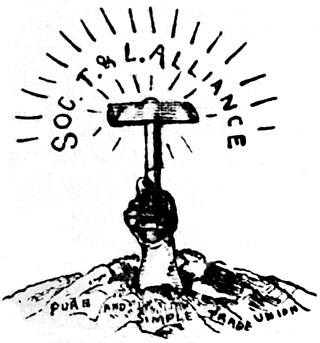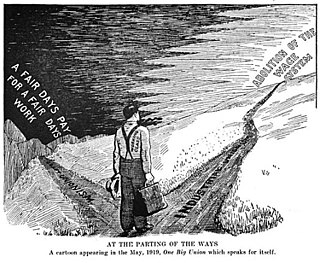
The Industrial Workers of the World (IWW), whose members are nicknamed "Wobblies", is an international labor union founded in Chicago in 1905. The nickname's origin is uncertain. Its ideology combines general unionism with industrial unionism, as it is a general union, subdivided between the various industries which employ its members. The philosophy and tactics of the IWW are described as "revolutionary industrial unionism", with ties to socialist, syndicalist, and anarchist labor movements.

William Ernst Trautmann was an American trade unionist who was the founding general-secretary of the Industrial Workers of the World (IWW) and one of six people who initially laid plans for the organization in 1904.
Industrial unionism is a trade union organising method through which all workers in the same industry are organized into the same union, regardless of skill or trade, thus giving workers in one industry, or in all industries, more leverage in bargaining and in strike situations. De Leon believed that militarized Industrial unions would be the vehicle of class struggle.

The One Big Union is an idea originating in the late 19th and early 20th centuries amongst trade unionists to unite the interests of workers and offer solutions to all labour problems.

Arthur Elmer Reimer was an American socialist political activist and politician who served as the presidential candidate of the Socialist Labor Party of America twice.

The Socialist Trade and Labor Alliance – commonly abbreviated STLA or ST&LA – was a revolutionary socialist labor union in the United States closely linked to the Socialist Labor Party (SLP), which existed from 1895 until becoming a part of the Industrial Workers of the World at its founding in 1905. During its existence, the STLA essentially operated as the revolutionary, "dual union" wing of the SLP.
Labor federation competition in the United States is a history of the labor movement, considering U.S. labor organizations and federations that have been regional, national, or international in scope, and that have united organizations of disparate groups of workers. Union philosophy and ideology changed from one period to another, conflicting at times. Government actions have controlled, or legislated against particular industrial actions or labor entities, resulting in the diminishing of one labor federation entity or the advance of another.
When Bill Haywood used a board to gavel to order the first convention of the Industrial Workers of the World (IWW), he announced, "this is the Continental Congress of the working class. We are here to confederate the workers of this country into a working class movement that shall have for its purpose the emancipation of the working class..."
Wobbly lingo is a collection of technical language, jargon, and historic slang used by the Industrial Workers of the World, known as the Wobblies, for more than a century. Many Wobbly terms derive from or are coextensive with hobo expressions used through the 1940s.

The Industrial Workers of the World (IWW) is a union of wage workers which was formed in Chicago in 1905 by militant unionists and their supporters due to anger over the conservatism, philosophy, and craft-based structure of the American Federation of Labor (AFL). Throughout the early part of the 20th century, the philosophy and tactics of the IWW were frequently in direct conflict with those of the AFL concerning the best ways to organize workers, and how to best improve the society in which they toiled. The AFL had one guiding principle—"pure and simple trade unionism", often summarized with the slogan "a fair day's pay for a fair day's work." The IWW embraced two guiding principles, fighting like the AFL for better wages, hours, and conditions, but also promoting an eventual, permanent solution to the problems of strikes, injunctions, bull pens, and union scabbing.

Maximillian Sebastian Hayes was an American newspaper editor, trade union activist, and socialist politician. In 1912 Hayes became the first candidate to challenge Samuel Gompers for the presidency of the American Federation of Labor in nearly a decade, drawing about 30 percent of the vote in his losing effort. Hayes is best remembered as the long-time editor of the Cleveland Citizen and as the vice presidential candidate of the Farmer–Labor Party ticket in 1920.

Frank Bohn was an advocate of industrial unionism who was a founding member of the Industrial Workers of the World. From 1906 to 1908 he was the National Secretary of the Socialist Labor Party of America, before leaving to join forces with the rival Socialist Party of America. After World War I his politics became increasingly nationalistic and he left the labor movement altogether.

The Industrial Workers of Great Britain was a group which promoted industrial unionism in the early 20th century.

The Social Democracy of America (SDA), later known as the Cooperative Brotherhood, was a short lived political party in the United States that sought to combine the planting of an intentional community with political action in order to create a socialist society. It was an organizational forerunner of both the Socialist Party of America (SPA) and the Burley, Washington cooperative socialist colony.
The Industrial Workers of the World (IWW) is a union of wage workers which was formed in Chicago in 1905. The IWW experienced a number of divisions and splits during its early history.
The Industrial Union Bulletin was a newspaper published by the Industrial Workers of the World (IWW), a labor union.

Arthur Patrick L. "Pat" Quinlan (1883–1948) was an Irish trade union organizer, journalist, and socialist political activist. Quinlan is best remembered for the part he played as an organizer for the Industrial Workers of the World in the 1913 Paterson silk strike — an event which led to his imprisonment for two years in the New Jersey State Penitentiary.

The Socialist Labour Party was a socialist political party in the United Kingdom. It was established in 1903 as a splinter from the Social Democratic Federation (SDF) by James Connolly, Neil Maclean and SDF members impressed with the politics of the American socialist Daniel De Leon, a Marxist theoretician and leading figure of the Socialist Labor Party of America. After decades of existence as a tiny organisation, the group was finally disbanded in 1980.

The Socialist Labor Party (SLP) is a political party in the United States. It was established in 1876, and was the first socialist party formed in the country.

Daniel De Leon, alternatively spelt Daniel de León, was a Curaçaoan-American socialist newspaper editor, politician, Marxist theoretician, and trade union organizer. He is regarded as the forefather of the idea of revolutionary industrial unionism and was the leading figure in the Socialist Labor Party of America from 1890 until the time of his death. De Leon was a co-founder of the Industrial Workers of the World and much of his ideas and philosophy contributed to the creations of Socialist Labor parties across the world, including: Australia, the United Kingdom, Canada, and the Socialist Trade and Labor Alliance.














